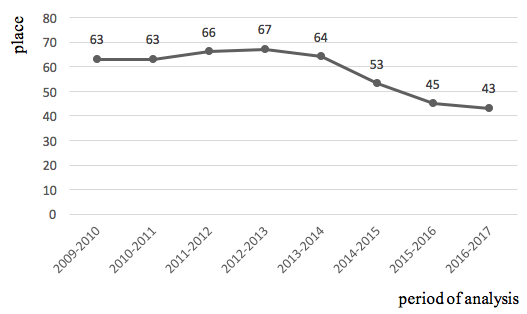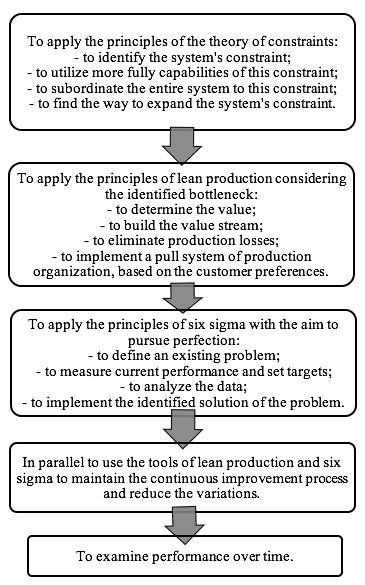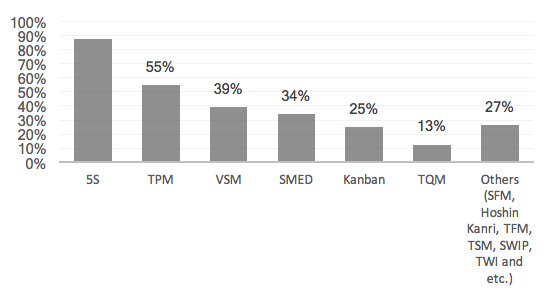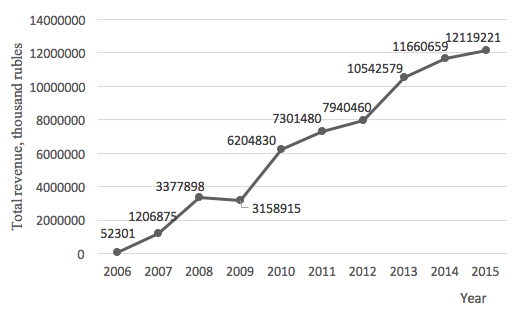

Vol. 38 (Nº 53) Year 2017. Page 31
Elena S. BALASHOVA 1; Elizaveta A. GROMOVA 2
Received: 02/11/2017 • Approved: 05/11/2017
ABSTRACT: Russian economy is in crisis from the end of the 2014. Structural changes of the Russian industrial sector are required. In the current realities, the issues of the competitiveness have become particularly relevant. Over 100 Russian industrial enterprises were examined. Representatives of the state corporations «Rosatom» and «Rostec», the industrial group «Basic element», JSC «Russian Railways» and large Russian enterprises were analyzed. A lot of companies use the principles of the lean production. And combination of modern organizational technologies in Russian industry were also detected. The sequence of stages of implementation of the integration of three models: lean production, the theory of constraints and six sigma was proposed. This methodology was suggested as a promising in the context of Russian industrial sector development. |
RESUMEN: La economía rusa está en crisis desde el final del 2014. Los cambios estructurales de la federación de industriales del sector son necesarios. En la actual realidad , los problemas de la competitividad se han vuelto especialmente relevantes. Más de 100 empresas industriales rusas fueron examinadas. Los representantes de las corporaciones estatales "Rosatom" y "Rostec", el grupo industrial "elemento Básico", JSC "Ferrocarriles de Rusia" y las grandes empresas rusas fueron analizados. Una gran cantidad de empresas que utilizan los principios de la Lean Production y la combinación de modernas tecnologías organizacionales en la industria de Rusia también se han detectado. La secuencia de las etapas de la implementación de la integración de los tres modelos: lean production, la teoría de las restricciones y seis sigma han sido propuestos. Esta metodología se ha sugerido como prometedora en el contexto del desarrollo del sector industrial de Rusia. |
Turbulent economic development is currently a distinctive feature of the world community. Russia is in crisis, which started at the end of 2014. Uncertainty and instability characterize the state of the national economy. In this regard, the need to implement effective models of management in the national companies representing the industrial sector of the economy, comes to the fore. The concept of "competitiveness" is rather complex and determines the position of the country in the world rankings according to many indicators. Currently, the Global Competitiveness Index, created for the World Economic Forum by Xavier Sala-i-Martin (professor of the Columbia University) is the primary tool of the generalized assessment of countries' competitiveness (figure 1).
Over the last analyzed period, Russia's rating has risen on two positions. Despite the fact that today the Russian economy is in recession, some of its main macroeconomic indicators are profitably differ from those of other countries, except the relatively high level of the inflation. The factors pointing to the use of internal reserve capacity in the activities of industrial enterprises, such as innovative potential, the competition level in markets of goods and services, the distribution of resources within the country, are unacceptably low.
The course on structural economic changes and import substitution taken by the Russian Government in a recession economy involves the actualization of the questions of Russian industry competitiveness increase. Therefore, it is worth noting the need to use competitive effective organizational management technologies at the industrial enterprises of Russia. World experience of development of the industry demonstrates that more and more companies make their choice in favor of combining different modern business models, trying to take the best from several concepts of management at the same time.
Figure 1
The dynamics of the places that were occupied by Russia on the
basis of the Global Competitiveness Index in 2009-2017, developed
by the authors

Problems of formation and implementation the competitive management models in unstable economic conditions are explored in the works of foreign and local authors. Among foreign researchers are T. Ohno (1978), J. Womack and D. Jones (1996), M. Imai (1997), E. Deming (1982), P. Pande, R. Neuman and R. Cavanagh (2000), E. Goldratt and J. Cox (1984), E. Goldratt (1997), J. Cox, S. Bergland and D. Jacob (2010) and others. Among the national scientists, we should mention V.V. Glukhov (2012), G.B. Kleiner (2011), V.S. Katkalo (2002) and others.
Modern management is a field of science, which is presented by the scientific schools and trends, considering the efficiency problem from the different points of view and sides. However, the basic models have similar goals, based on the following principles:
Lean production (Ohno, 1988; Womack and Jones, 2003; Imai, 1997), the theory of constraints (Goldratt and Cox, 1984; Goldratt, 1997) and six sigma (Pande et al., 2000) are popular and common models of management. Each of them has advantages and disadvantages, but it is obviously that each model has proved itself from the best side in international practice. Missions of these models are the most distinct features that link them. Each model is a programme of improvements. The Deming cycle (PDCA) (Deming, 1982) is the basis of the algorithm logics of improvement the processes of the above-mentioned concepts. According to the modern scientists (Cox et al, 2010; Sproull and Nelson, 2012; Pirasteh and Fox, 2010; Sproull, 2012), combination of the lean production, the theory of constraints and six sigma with the aim to take the best practices from each management model is an effective measure. This integration is designed relative to the specified conditions of the micro and the macro environment and the general philosophy of the company. So, implementation of the integrated business model seems to be a rational step to overcome the difficulties associated with the current extremely high international competition.
It is noteworthy, that for the first time combination of the above mentioned organizational technologies has been tested with the aim of establishing logistics processes in the U.S. army (Dumond, 2001). This experience had a success. Nowadays due to the conducted experiment in the large American electronics company (Pirasteh and Farah, 2006), integrated management model clearly showed its effectiveness in comparison with lean production and six sigma. The conditions of this experiment were follow. For more than 2 years 101 projects were executed on the 21 company's plants. According to the initially assigned distribution: 4 plants applied lean production, 11 - six sigma, and 6 – combination of three concepts: lean production, the theory of constraints and six sigma. All other conditions were equal. As a result, the percentage share of contribution to the savings by the integrated model was 89%, by the theory of constraints was 7% and by lean production was 4%. This result demonstrated the achievement of synergistic effect in the company.
Group of the scholars (Cox et al., 2010) formulated the operation principle of the combined model's mechanism. Lean production and six sigma work better within the theory of constraints than without it. As with the assistance of the theory of constraints, it is possible to create rapidly a stable system and then improve it using lean production and six sigma. But it is important to keep the main constraint that sets the speed of the process. The scientists shifted the management paradigm from using of single theory to symbiosis of several theories. Thus, the methodology of implementation of the integrated model is shown in figure 2.
Figure 2
The sequence of stages of the integrated
model, developed by the authors

It is important, before the introduction the combined model, all employees of different levels must be well-trained and are aware of the principles of this model and of each model separately. The final goal is to design the mechanism of functioning of the company, which is distinguished by its agility.
Over 100 companies were analyzed in the study of Russian industrial sector. There are representatives of the state corporations "Rosatom" and "Rostec", JSC "Russian Railways", industrial group "Basic element" and other major companies. The obtained results are sufficiently demonstrative in the context of modern organizational technologies development in Russia.
Since the beginning of XXI-th century the concept of lean production has spread in Russia at the "Ford Motor Company" in the Leningrad region. Today various models of modern resource management are applied in Russian industry (Kleiner, 2011; Katkalo, 2002; Balashova and Gromova, 2016, 2017). But, no doubt, production systems based on the lean production principles predominate at the analyzed enterprises.
Considering the use of lean production at the industrial enterprises, two trends were revealed. The first is the saturation of the domestic market by foreign companies, who have extensive experience in the application of the concept, and actively support its implementation in Russian market by providing consulting services. Among the companies that provide significant support to Russian enterprises in the development of lean production principles, the following stand out: Daimler, Renault-Nissan Alliance, Dupont, Snecma, Boeing, General Electric, Pratt and Whitney, Schneider Electric, McKinsey & Company, Lean Management Institute, Lean Coaching. And the second trend is the independent interpretation of the implementation stages and the concept in general by the Russian enterprises. The percentage ratio clearly shows the overwhelming superiority of the second path of development (84.52%/ 15.48%).
From the position of the set of tools used at the domestic industrial enterprises, 5S plays a leading role. This tool is a practical methodology for the formation and maintenance of a working order in the process of value added creating (Glukhov et al., 2012). Its leading position is explained by the simplicity and linear model of introduction. A large variety in the selection of tools is another feature that was revealed in the research process. The results of instrumental analysis of the industrial enterprises that implement lean production shown in figure 3.
Figure 3
The tools of lean production that used at the
Russian enterprises, developed by the authors

More one principal feature of the production systems of the enterprises is a combining the various contemporary organizational technologies. Obviously, in current realities the symbiosis of the modern resource management models is able to positively influence on the target performance indicators of enterprises. This trend is also reflected in the Russian industrial sector of economy.
Therefore, United Engine Corporation - Gas Turbines (UEC-GT, JSC) is a remarkable example of the implementation of the combination of the lean production, the theory of constraints and six sigma in Russia. It is the leading company for manufacturing of the power generating and gas compressor sets as well as for the power plants turnkey construction. Full production cycle allows for the shortest possible lead time and high quality of products and services. The main principles are:
In 2009 the UEC-GT embarked on the path of global transformation that resulted in the creation of the production system based on continuous improvement principles and quality improvement processes. In May 2009, special department conducted the first steps of transformation — deployment of 5S and kaizen and working groups in the workshops were formed. The emphasis of the effort was directed primarily at the main production units. Employees in the framework of the "continuous learning" at least once in a quarter receive training on lean production, theory of constraints and six sigma in Moscow, St.-Petersburg, Nizhny Novgorod, Ekaterinburg. The results of the first year of implementation of this integrated model are: 37% of employees were involved in the continuous improvement process, and the economic effect amounted to about 400 million rubles. In addition, master-classes in areas of production workshops with participation of specialists of the NPO «Saturn» and «Snecma» were carried out; the proposal submission system has been introduced; assessment of workplaces was performed; key performance indicators of working groups were identified and counted. Also in 2009 employees have made more than 170 suggestions for improvements. For the first 5 years, 86 projects were opened. In 56 of them, production took an active part. Such projects as «Cooperation-1», «Unification of pipe flanges», «Linked plans», «Growth of quality» and «Business of product» had a special meaning. The key of such successful changes was the combining of three management models. Dynamics of the company’s total revenue is significant evidence of the concept’s economic efficiency (figure 4).
Figure 4
Dynamics of the UEC-GT’s total revenue (2006-2015),
source: official website of the UEC - Gas Turbines

The United Engine Corporation - Gas Turbines is one of the few successful examples of using the symbiosis of the lean production, the theory of constraints and six sigma in Russia.
Another example of construction of an effective production system is United Company (UC RUSAL), which is part of the industrial group "Basic element". The UC RUSAL’s strategy also originates from 2009 and is based on the combination of the principles of lean production and six sigma. The characteristic features of the adopted production systems are: safety for production activities, continuous improvement of production processes, the involvement and training of staff, customer focus. The company uses a variety of tools such as 5S, SMED, jidoka, TPM, VSM, kanban, projects in A3 format. The adoption of the realization of about 23.8 thousand proposals for improvement became one of the most indicative results for the first five years of development. Combination of the above mentioned models was recognized a promising by the company's management.
Another example of integration of management models with the aim of increasing efficiency of production was detected. But the implementation of this business model was quite complicated. VSMPO-AVISMA Corporation is the world’s largest titanium manufacturer with the full production cycle: from raw-material processing to release of finished machined products. It is a strategic supplier for many companies. The corporation supplies its products to the markets of 50 different countries and is deeply integrated into the world’s aerospace industry. At the beginning, the management of the VSMPO-AVISMA took the decision to start using the concept of six sigma and sent 10 staff to training on the appropriate program level «Green belt». The reason for this was the desire of General Electric to obtain a reliable supplier. However, despite world recognition of the effectiveness of the methodology, a few years later, the project development was completed. The absence of understanding of the possibilities of improvement of technological and business processes using statistical methods of quality control by the employees, from top management to production workers, was the main reason for the failure of implementation of six sigma. Further, under the similar circumstances, guided by the need to meet the requirements of the Boeing Company, the introduction of the concept of lean production started. But soon the management of the Corporation understood that the interaction of organizational technologies is capable of achieving high performance. The experience of the VSMPO-AVISMA is extremely important and significant for the enterprises of the Russian industrial sector, seeking to improve competitiveness through the integration of management models.
Concluding the results of the study, the following features should be noted:
Balashova E.S., and Gromova E.A. (2016). Resource-based view as a perspective management model in Russian reality. Problems and Perspectives in Management. 14(2), 325-330.
Balashova E.S., and Gromova E.A. (2017). TQM as one of the drivers of Russian industrial sector. Quality – Access to Success. 159, 50-53.
Cox J., Bergland S., and Jacob D. (2010). Velocity Combining Lean Six Sigma and the TOC to achieve breakthrough performance. New York: Free Press.
Deming E. (1982). Out of the crisis. Cambridge MA: MIT Press.
Dumond J. (2001). Velocity management. The business paradigm that has transformed U.S. army logistics. Santa Monica: RAND Corporation.
Glukhov V.V. et al. (2012). Resource management: methods of identifying production reserves. SPb: Publishing house Science.
Goldratt E. (1997). Critical chain. Great Barrington: North River Press Publishing Corporation.
Goldratt E., and Cox J. (1984). The Goal. Great Barrington: North River Press Publishing Corporation.
Imai M. (1997). Gemba Kaizen: A Commonsense Low-Cost Approach to Management. New York: McGraw-Hill.
Katkalo V.S. (2002). Resource-based view of strategic management: Genesis of basic ideas and concepts. Vestnik SpbGU. 4(32), 20-42.
Kleiner G.B. (2011). The resource theory of systemic organization of economy. Russian management journal. 9(3), 3-28.
Ohno T. (1988). Toyota Production System. New York: Productivity Press.
Pande P.S., Neuman R.P., and Cavanagh R.R. (2000). The six sigma way How GE Motorola and other top companies are honing their performance. New York: McGraw-Hill.
Pirasteh R.M., and Farah K. (2006). Continuous Improvement Trio: The Top Element of TOC, Lean and Six Sigma Make Music Together. APICS. 16(5), 31-33.
Pirasteh R.M., and Fox R.E. (2010). Profitability with No Boundaries Optimizing Toc and Lean-Six Sigma. Wisconsin: ASQ Quality Press.
Sproull B. (2012). The ultimate improvement cycle Maximizing profits through the integration of lean six sigma and the theory of constraints. New York: A Productivity Press Book.
Sproull R., and Nelson B. (2012). Integrating Theory of Constraints Lean and Six Sigma TLS. Great Barrington: North River Press Publishing Corporation.
Womack J.P., and Jones D.T. (2003). Lean Thinking. New York: Free Press.
1. Peter the Great St. Petersburg Polytechnic University. Contact e-mail: elenabalashova@mail.ru
2. Peter the Great St. Petersburg Polytechnic University. Contact e-mail: lizaveta-90@yandex.ru